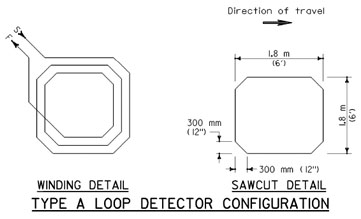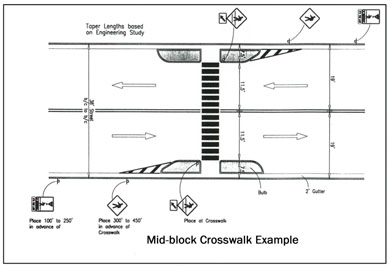Bicycle Detection Solutions
Inductive loop sensors, commonly used for detection of traffic at demand-actuated traffic signals, can be configured and adjusted to detect bicycles with metal rims. Inductive-loop traffic detector systems operate by sensing disturbances to the electromagnetic field over a coil of wire built into the roadway (Figure 1). When a conductive object (typically made of metal) enters the area over the wire loop, the magnetic field generated by alternating electrical current in the signal detector circuit induces weak electrical currents in the conductive object. (The AC frequency may be between 10,000 and 200,000 Hz, typically around 20,000 – 30,000 Hz.) The electrical currents induced in the object generate their own magnetic field that works in opposition to the magnetic field generated by the sensor coil. This opposition changes the resonant frequency of the sensor circuit by reducing the effective inductance of the sensor coil. This change in resonant frequency (an increase in frequency as the inductance decreases) is detected by the circuit instrumentation in the signal controller cabinet, which then tells the signal control electronics that a vehicle is present.


Mid-block Pedestrian Crossing
A mid-block crosswalk is defined as a crosswalk at a location other than an intersection and can be used to improve safety for pedestrians crossing at a specific location. To be effective at improving safety, a midblock crosswalk should be installed at specific locations where pedestrians would be expected to cross the street. If the pedestrian crossings are occurring at random locations within a block and if vehicle volumes are low or moderate it is likely that most pedestrians will not alter their route by more than a few yards to use the crosswalk. Consideration should be given to the safety of all pedestrians (younger and older pedestrians) who may use a proposed mid-block crosswalk.
Crosswalk locations must allow motorists to safely yield for pedestrians. Sight distance, roadway geometrics and the potential for rear-end type accidents should be evaluated. Streets with two traffic lanes in the same direction present a potential hazard when a vehicle in one lane yields to a pedestrian and obstructs the sight line of the pedestrian for a motorist in the other lane.
The safety of mid-block crosswalks is dependent on the judgment of the pedestrian and the motorist. Engineering standards can help by making crosswalks more visible.
